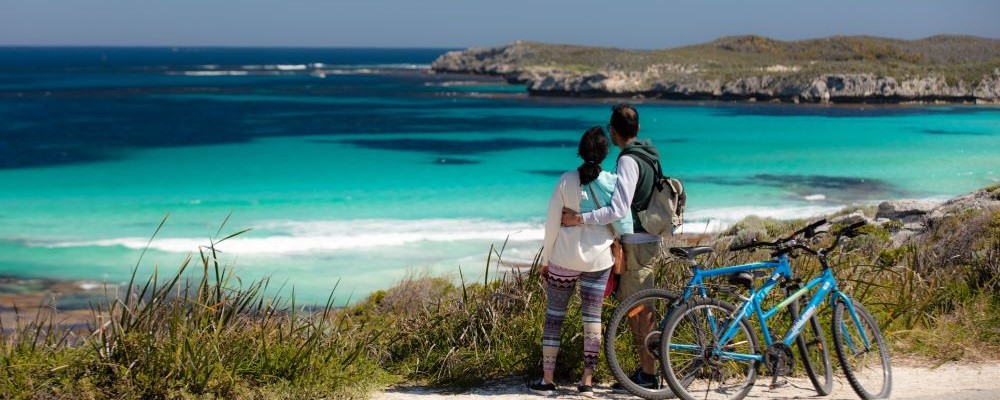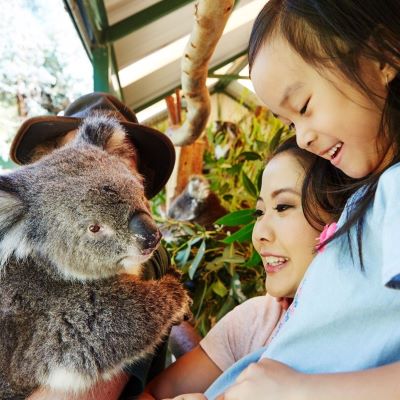Western Australia (WA) offers a comfortable lifestyle, great climate, incredible beaches, world class food and wine, vibrant arts and a rich cultural history, leading tourist attractions, a world class healthcare system and access to quality education.
Whether you choose city, suburban or country life — WA has something for everyone.
Here we have outlined just a few of the things that make WA such a great place to live.
Pictured: Tourism Australia; Migrant couple looking at the view of Salmon Bay after bike riding on Rottnest Island.

Food, culture, recreation and sport
Places to visit
There are many opportunities to enjoy the sights of WA within easy reach of Perth city and around the metropolitan area. For some ideas on where to go and what to see, here are a few of Perth’s most popular spots.
Wildlife
You can find a wide range of animals throughout Western Australia, across our different environments from coast to desert.
Our wildlife is just one of the things that make WA such a unique place to live, and perfect for nature lovers.
With our beautiful natural landscapes and clean waterways, WA is home to over 500 bird species.
Around Perth and its suburbs; you'll see many parrots including the black or the white cockatoo, and the rainbow lorikeet. There's also many different honeyeaters, as well as magpies and many more! The black swan, most seen on the Swan River, is an emblem of Perth. Two great spots for bird watching are Kings Park and Herdsman Lake.
Regional WA is home to many species of birds, with abundant natural environments ranging from wetlands to forests and dry landscapes.
Visit the Australia's Wonderful Birds website (opens in a new tab)to find out more about WA's birds.
The koala is native to Australia. Sometimes called a "koala bear" — the koala is actually not a bear, this name comes from its bear-like appearance.
Koalas are typically silver grey to chocolate brown in colour, with tufts of white hair on their face and ears. Koalas live mostly in forests of eucalyptus trees, as the leaves of these trees make up most of their diet. They can sleep up to twenty hours a day.
A popular spot to see koalas in a natural habitat is Yanchep National Park(opens in a new tab), where you can walk along the raised boardwalk and see into the top of the trees.
Crocodiles are generally found in the remote north west of the State. If you want to view a crocodile in its natural habitat, it is best to take a guided tour with an experienced guide to view them safely.
Western Australia has its share of snakes, which become more active in the warmer spring days. Should you encounter a snake, you should avoid approaching or aggravating it. Most bites occur when people accidentally step on snakes, or while attempting to kill them. First aid treatment for a snake bite(opens in a new tab) is available through St John first aid service.
There are numerous species of spiders in WA, each playing a beneficial role in our environment by eating insects. There are very few species in WA that are actually harmful. First aid treatment for a spider bite(opens in a new tab) is available through St John first aid service.
There are numerous protected marine parks and reefs across the State; the most popular is Ningaloo Marine Park(opens in a new tab), home to some of the world’s best diving spots. This is also where you can swim with whale sharks.
Monkey Mia in north WA offers a one on one experience of feeding and swimming with bottlenose dolphins and is also home to dugongs. The Bunbury Dolphin Discovery Centre in the South West offers a similar experience.
Southern right whales and humpbacks migrate during winter with their calves. Whale watching charters operate in Perth and regional areas with the best viewing in the South West region.
Part of the national emblem, the kangaroo, is a familiar sight around most parts of regional WA including around many of Perth's suburbs where natural bushland areas are available.
Take care when driving outside of the metropolitan area on country roads, as these large marsupials can jump out from bushland areas without warning.
The black swan is Western Australia's official bird emblem, and it appears on the WA flag(opens in a new tab).
They have long, slender necks which are longer than their bodies. They are black except for white wing quills, and their bill is broad and bright red. Baby swans, or cygnets, are grey.
You can often see black swans gliding gracefully along the Swan River in Perth, which was named the Swan River Colony in the 1830s as an English settlement, or in large lakes and waterways.

Pictured: Illustrations Photography; Migrant mother and daughter enjoying the experience of being up close to a koala at Caversham Wildlife Park, Swan Valley.